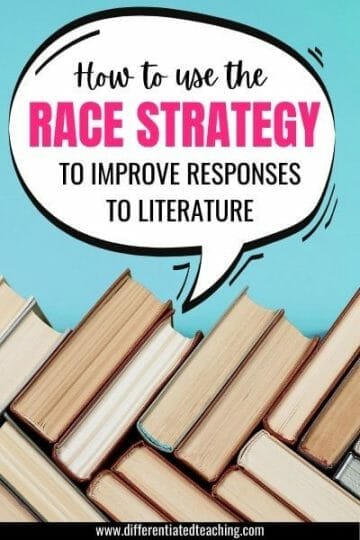Improving Personal Narratives with a Focus on Seed Stories
Every year one of the first writing units in our district’s curriculum requires me to teach personal narrative, and every year my students have struggled to understand the process of focusing their stories on a “small moment”. It’s taken me a while to figure out how to teach personal narratives so my students deeply understand, but after my campus adopted Lucy Calkin’s Units of Study, I found using the watermelon and seed analogy was a helpful tool in helping my students generate more focused stories about their lives.

One of the biggest barriers I’ve found when teaching narrative writing is that my students want to tell me EVERYTHING about what happened. You’ve probably experienced this same challenge.
The student decides to write about a special moment from their trip to Disney, and their story begins from the moment they got in the car to drive to the airport.
These stories turn into long lists of events rather than a sensory experience that allows the reader to visualize their experience. So how do we get our students to understand that they don’t need to give us every single detail?
What is a small moment in writing terms?
A small moment is just a fancy way to explain that students should focus their story on a single experience rather than a larger event. Small moment writing involves having students zoom in and focus on the sensory details and their thoughts and feelings during one specific point in time.
Small moment writing is often described through the analogy of a watermelon where the event itself is the entire watermelon and the small moments are the seeds. Others have used pizza to make the same comparison – in this case, the entire pizza is the whole situation and the individual components are the small moments.
Regardless of which way you teach small moments, it is important that students begin zooming in and giving details to avoid stories that are just lists of events. However, this can be a challenging concept for students to understand so it may require multiple lessons or exposures to personal narrative writing to get the level of depth and focus you want from your writers.
Ideas for teaching personal narratives & getting students to focus on small moments
Start with a hands-on visual to build the concept of a small moment
The first thing students need is an understanding of what a small moment really is. One of the best ways to do this is to provide a visual. Bring a watermelon into class, and slice it!
When you introduce the idea, have students observe and describe the watermelon. Discuss how hard it might be to carry the entire watermelon around for the day. Then cut the watermelon into slices, and give students a chance to observe the seeds.
Helpful Hint: Don’t buy a seedless watermelon!! Did that on accident one year and had to scramble to come up with a connection. If you accidentally get a seedless watermelon here’s what I came up with – Sometimes authors forget to focus on the seeds, and their stories are a lot less interesting.
Help students see that the seeds are an important part of the watermelon, but that they are a much smaller, easier to handle part. Have students imagine what it would be like to carry the watermelon seed around for the day. Not so challenging, right?
From here you can help students connect that concept that the big watermelon is like some of the stories they’ve written before. It contains a list of event, but it doesn’t really give the reader anything to enjoy.
Use a concept sort to help students solidify what a small moment is.
Before students can really start honing in on what a small moment is, they need some experience identifying them.
Consider having students work through a concept sort that contains examples and non-examples.
Having a strong understanding of what a small moment truly is can help students identify the “seed moments” in their own experiences more easily.
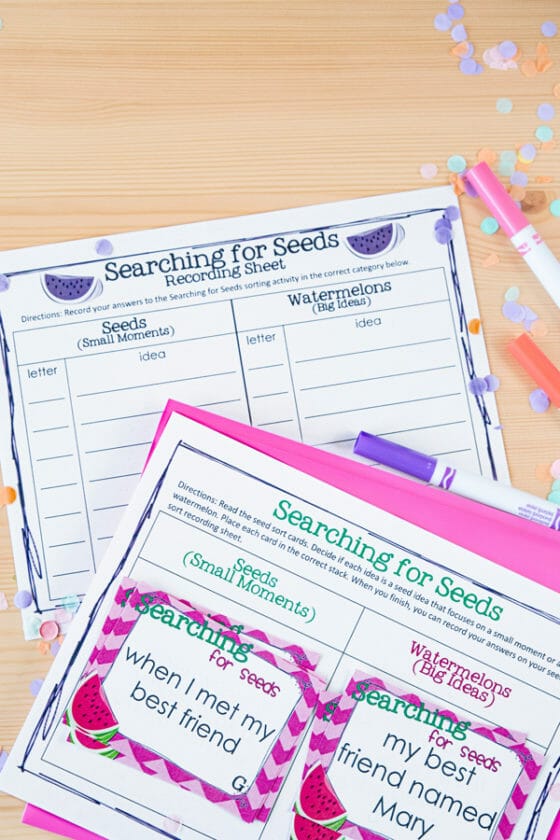
This activity can also help you identify students who may still have misconceptions about what a small moment is BEFORE they start writing.
After students have done an activity like this as a group, you can give them an individual sort as a way to quickly assess their understanding. This can be especially helpful when you have students who rely on peers when working in groups but struggle once left to their work.
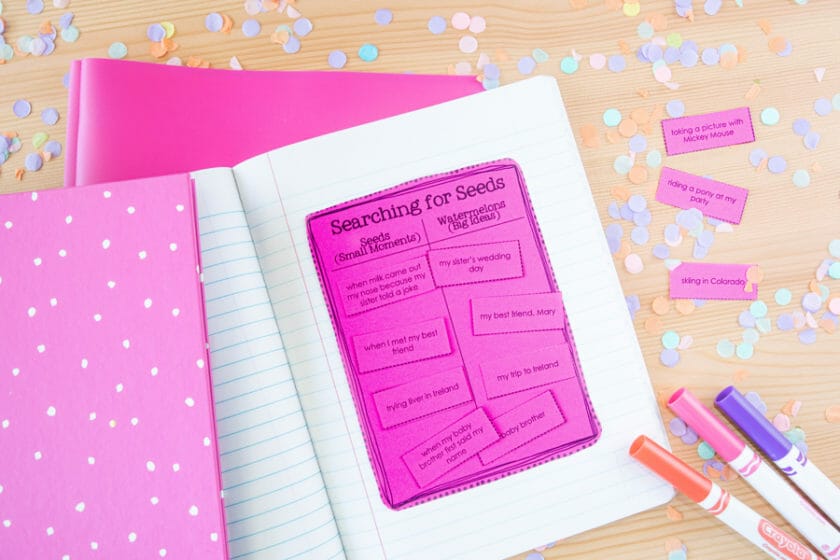
Brainstorm watermelon and seed ideas.
Most of us start the year by having students work on some brainstorming. They create lists of special people and places. They draw pictures of events that were important to them. Basically, they create an idea bank for their writing.
This is a chance to allow them to see how they can take ideas from their idea bank and turn them into actual stories.
Take a few of the ideas students have generated in their idea bank, and have students try to identify 2-4 seeds in each one.
This gives them a chance to break down their larger stories into more manageable moments that they can write about.
A graphic organizer, like this one, can be really helpful for making the connection between the larger event and the focused ideas for writing.
It can also be helpful to bring students together to share their organizers so that students can learn from one another.
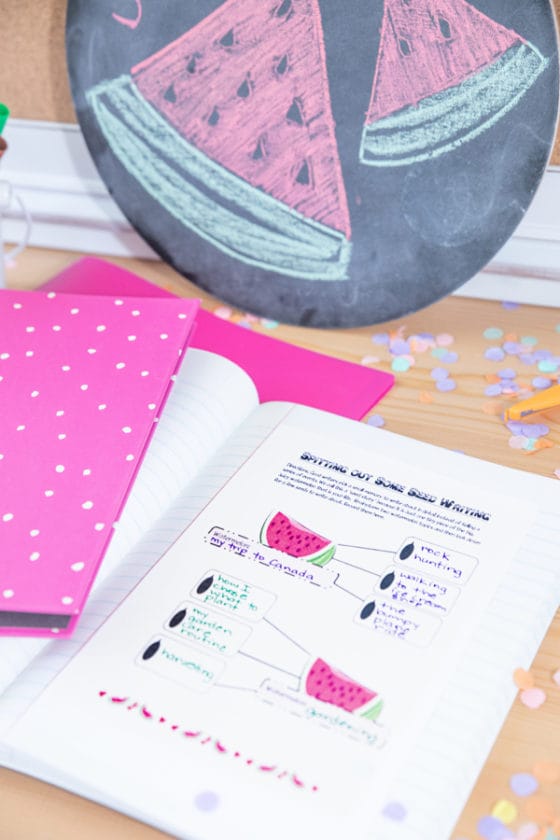
How can I improve my students’ narrative writing once they’ve got the concept of a small moment?
Personal narratives should be filled with emotion and the reader should be able to feel like they are there with the author. However, when students focus on a large event, they don’t give these descriptive details because most of them just want to get the story out. That’s why helping students understand the concept of a small moment is the first step. But where do we go from there?
Create a sensory graphic organizer.
Whether you teach 1st grade or 5th grade, all writers can benefit from taking time to brainstorm the details of their small moment. It is important to do this BEFORE students start writing because once they’ve begun, it can be challenging to get them to slow down and really relive the moment as a movie in their mind. This is also a great strategy to help reluctant writers not feel so overwhelmed when they’re getting started. Click here to find more strategies to support reluctant writers.
I love using a graphic organizer to help students brainstorm because they can keep it in their writing journal and refer it throughout the writing process.
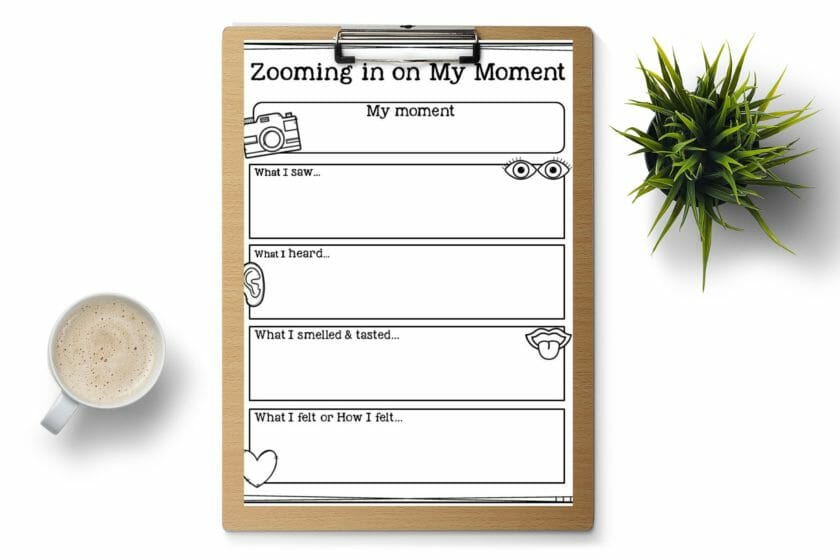
Having students take time to visualize and record the sensory details of their topic can help them as they start writing, but it can also be a great reference when you work on revising or editing their writing later.
Students could also create a web graphic organizer if you prefer. Just make sure that students are really taking the time to visualize their moment and replay it in their minds. This is likely to take an entire writing period, but it will pay off when your students create much richer drafts.
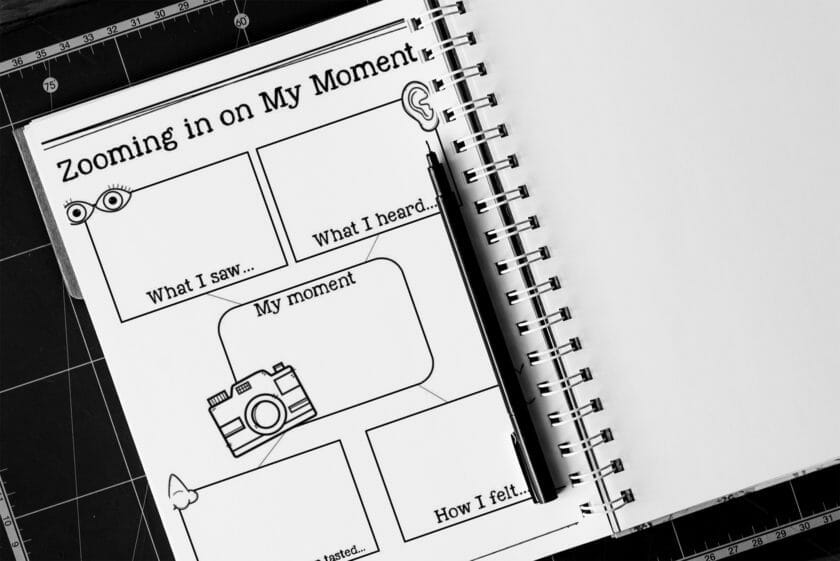
If you want to use this graphic organizer, and several others, to help your students develop their personal narratives, enter your information to get free access.
Help students write a step-by-step plan
Once students have relived their small moment in their mind, it is time for them to get the ideas out on paper. However, many students will revert to the “list story” if you don’t provide some structure to get them started.
Teaching kids how to create a plan for their story is an important step, and it can take 1-2 class periods to complete. Creating a step-by-step plan is one way to help students feel more confident when they begin drafting their personal narratives.

I like to have my students sketch out their story before they begin writing because they often include details in their images that we can use later to add depth to their writing.
We use this organizer to create our draft. For younger students, this might only be a paragraph or two. However, my older students would create a paragraph on each of the chunks of the organizers.
Books to help you teach personal narrative writing
There are a number of great books that I like to use when I teach personal narrative writing to my students.
Mentor texts are important because they really help students see how a published author uses the strategies you’re teaching. However, I am also picky about which books I select because I want them to be engaging and approachable for students. They need to actually be able to identify the components of the personal narrative within the stories you select.
They also need to be able to see the strategies you’re teaching. That means you need really focused stories that are full of rich, descriptive language. Here are some of my favorite narrative picture books I use to teach this writing unit:
- The Relatives Came by Cynthia Rylant
- Fireflies by Julie Brinklow
- Roller Coaster by Marla Frazee
- Shortcut by Donald Crews
- A Moment in Time by Jennifer Butenas
15 Quick Small Moment Story Ideas
One of the biggest things I’ve found is that studnets hate writing about the same things year after year. You’ll want to find ways to keep your topics fresh and fun.
If you’re looking for some quick ideas for your next topic to write about, here are some small moment story ideas to get your writers started.
- Write about a time you felt really proud of yourself.
- Write about a time when you were surprised by something good that happened to you.
- Write about a time when you had to be brave.
- Write about a time when you made a new friend.
- Write about a time when you did something you were scared to do.
- Write about a time when you accomplished something you didn’t think you could do.
- Write about a time when you felt really happy.
- Write about a time when you helped someone.
- Write about a time when you felt really proud of your family or friends.
- Write about a time when you felt really embarrassed.
- Write about a time when something really funny happened to you.
- Write about a time when you were bored and what you did to entertain yourself.
- Write about a time when you were really mad at someone.
- Write about a time when you were really sad.
- Write about a time when you had to apologize to someone.
Grab my free graphic organizers to help you get started
To save you time, I’ve created a free set of graphic organizers that you can use to help get your students started with personal narratives.
This pack includes graphic organizers to help your students focus their ideas into small moments and then record the sensory details associated with the memory. Grab it now to make teaching your personal narrative unit easier.



